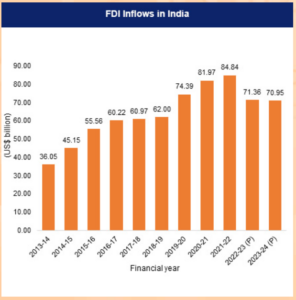
India has immense potential to become a top destination for Foreign Direct Investment (FDI), but it has yet to fully capitalise on this opportunity. In a recent call for an Investment-friendly Charter during the 9th Governing Council Meeting of NITI Aayog, Prime Minister Narendra Modi emphasised the need for strategic reforms to enhance India’s appeal to global investors. Can overcome its disadvantages and become an attractive destination for FDI?
India’s FDI inflows stand at a modest 1.1% of its GDP, with the country receiving $44.4 billion in FY2024. While it was the 7th largest FDI recipient in 2022 with $49.4 billion, it lagged behind countries like China ($189.1 billion), Brazil ($86.1 billion), Australia ($61.6 billion), and Canada ($52.6 billion).
A significant issue is the concentration of FDI sources, with Singapore and Mauritius accounting for 49% of cumulative FDI from April 2001 to March 2024, raising concerns about potential tax treaty abuses and limited genuine economic development. Moreover, India’s FDI is heavily directed towards trading, services, malls, and real estate development. Manufacturing attracts only around 30% of FDI, with critical sectors like electronics and technology underfunded. For instance, telecom received only $713 million in FY2023 and $282 million in FY2024. This skewed distribution hinders the development of high-value industries essential for robust economic growth.
READ I Education and health cess utilisation must undergo social audit
Reducing cost disadvantages
Reducing cost disadvantages for firms considering relocating to India is a vital step to make the country an attractive destination for FDI, says a study by Global Trade Research Initiative. To attract businesses relocating from China or considering alternative production locations, India must offer a more competitive cost structure. India faces higher raw material costs due to import dependence and high tariffs, while China benefits from large-scale local production and efficient supply chains, and Vietnam offers competitive costs with low or zero tariffs on imports. Labor costs in India, though lower than in China, at around $2 per hour compared to China’s $3 to $4 per hour, are still higher than Vietnam’s $1.5 per hour.
Lowering labour costs further could make India more attractive. Additionally, industrial electricity costs in India range from $0.08 to $0.10 per kWh, higher than China’s $0.06 to $0.08 and Vietnam’s $0.08 to $0.09 per kWh. Lowering energy costs through policy measures and investments in renewable energy could help. Despite significant investments, India’s infrastructure and logistics efficiency still lag behind China’s advanced systems and Vietnam’s improving infrastructure.
Enhancing logistics through dedicated freight corridors and strategically locating industrial zones near ports can streamline production and shipping processes. Financial costs in India are the highest, with lending rates around 9-10%, compared to China’s 4-5% and Vietnam’s 7-8%. Reducing financial costs through monetary policy adjustments and financial sector reforms is essential.
Enhancing ease of doing business
Improving the ease of doing business is critical for attracting and retaining FDI. A comprehensive approach can address key areas from starting a business to exporting. Firstly, it is essential to identify priority sectors, particularly those where India’s manufacturing and export capabilities are currently weak, such as electronics, computers, telecom, precision equipment, and factory machinery.
The production-linked incentive (PLI) scheme should be recast to support high-value addition and deep manufacturing in these sectors. Inviting top global firms as anchor manufacturers can drive technological innovation and improve productivity across sectors. For instance, Suzuki’s entry into India’s automobile sector significantly boosted the industry’s overall productivity. Attracting smartphone makers like Samsung and Apple with a greater focus on local value addition can further enhance India’s manufacturing landscape.
Developing effective coordination with lead investors involves facilitating direct communication between senior government officials and investors and assigning dedicated officers to assist investors throughout the project lifecycle. Such measures help address issues promptly and build investor confidence. Providing ready-to-manufacture space by establishing operation-ready industrial zones with pre-approved permissions allows investors to start production quickly. The 2024 budget’s proposal to create 100 “plug and play” industrial zones is a significant move in this direction.
Improving logistics through dedicated freight corridors and strategically locating industrial zones near ports will streamline port and customs processes, facilitating faster shipments. Ensuring policy predictability by maintaining a stable policy environment, avoiding retroactive changes, and clarifying tax laws will enhance investor confidence and reduce disputes. Additionally, setting up quick dispute resolution systems is vital. Establishing efficient mechanisms for resolving commercial disputes promptly will be crucial for enforcing contracts and boosting investor confidence, as long court delays have been a significant deterrent in the past.
Evaluating FDI proposals
Creating a robust framework for evaluating investment proposals is also essential. This framework should ensure alignment with national interests, support sustainable economic growth, and protect strategic autonomy. Investments should focus on industries that can enhance exports and technological capabilities, such as electronics, telecommunications, and precision machinery. It is important to consider the impact on Micro, Small, and Medium Enterprises (MSMEs), which are crucial for employment and economic diversity. Investments should promote MSME growth rather than displace them.
Ensuring technology transfer is vital for enhancing local technological capabilities, particularly in high-tech areas where India aims to close gaps. The framework must include strict checks to prevent risks to national security, especially in defence, telecommunications, and infrastructure. Safeguarding these sectors is crucial for national security and resilience. Additionally, avoiding economic dependence on foreign entities is essential, as this could compromise India’s strategic autonomy and decision-making in key industries.
Sustaining FDI growth
Beyond these measures, there are additional considerations to ensure a sustained increase in FDI inflows. The government’s recent reduction of corporate tax for foreign companies from 40% to 35% is a positive step towards a globally acceptable tax rate of 18 to 25%. Easing regulations for foreign companies is also important for improving the ease of doing business in India. Execution of these policies on the ground will significantly impact foreign companies and needs to be ensured. The opportunity for India lies not only in attracting large corporations but also in fostering partnerships between foreign investors and MSMEs.
MSMEs can optimize employability and leverage cost differentials, presenting a big opportunity for India. Focusing on emerging technologies and deep tech is crucial for attracting more foreign flows. As a country, India must strategically invest in critical and emerging technologies, which are essential for maintaining global competitiveness. Long-term FDI into India, particularly through manufacturing, should be a focus, with efforts towards making India a product IP-led country. Investing deeply in sectors like video gaming and new-age wellness, where there is potential for foreign strategic and financial investments, is also vital.
India’s unlocking story will largely come through digital and green initiatives. The digital public infrastructure story that India has put out can become a global model for other countries. Emphasizing research and development (R&D) is the core for growth, and India must set standards and lead the world in many emerging technologies. This comprehensive approach will not only boost FDI inflows but also contribute to sustainable economic growth and development. By addressing cost disadvantages, improving the ease of doing business, creating a robust framework for evaluating investment proposals, and focusing on emerging technologies and digital initiatives, India can position itself as a leading choice for global investors.

